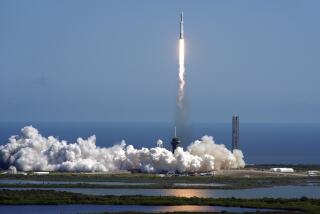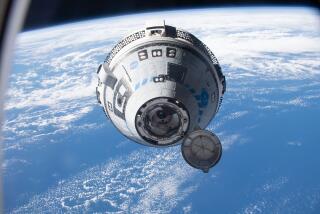Atlantis blasts off for Hubble repairs
- Share via
The space shuttle Atlantis blasted off Monday from Kennedy Space Center in Florida on a challenging 11-day mission to repair and upgrade the Hubble Space Telescope.
The shuttle and its seven-person crew lifted off on schedule at 2 p.m. EDT, reaching orbit after an eight-minute jump from a standing start to 17,000 mph.
At a post-launch media briefing, NASA officials said it appeared the spacecraft had performed nearly flawlessly. The only concerns were a small ice buildup on the orbiter just before the engines started and a false signal from the left engine that sent an alarm ringing through the spacecraft during launch. Controllers in Houston quickly reassured the crew the alarm was nothing to worry about and the launch proceeded smoothly.
The biggest job for the crew on the first day was properly aligning the shuttle to rendezvous with the space telescope on the third day of the mission. The crew also began inspecting the orbiter’s nose cone for signs of damage. On-orbit inspections have become routine since the shuttle Columbia was destroyed in 2003, killing its seven crew members. A piece of insulating foam from the exterior fuel tank had hit the left wing of Columbia during launch. The damage escaped the crew’s notice, and the orbiter broke up on reentry.
NASA officials said Monday that small pieces of foam appeared to have come off during the Atlantis launch, but that they were not considered to be a threat.
“This was a great start to a real challenging mission,” said Bill Gerstenmaier, associate administrator for space operations.
Many of Hubble’s instruments are broken or compromised, adding to the difficulty of this mission. Over five spacewalks, the Atlantis crew will replace gyroscopes and batteries, along with the workhorse Wide Field Camera 2, the instrument that has taken most of the stunning pictures of deep space for which Hubble is famous.
The crew will also attempt in-space repairs of the Advanced Camera for Surveys, as well as a spectroscope that breaks down the light of stars, enabling scientists to tell how far away they are, among other things.
These instruments were never designed to be repaired, and NASA is not confident the repairs will succeed. The astronauts will be using 116 tools developed for this mission.
An additional challenge facing the crew is the fact that the space telescope orbits in a debris-riddled region of space 375 miles from Earth. That increases the danger that the orbiter could be hit and incapacitated by a piece of space junk, leaving the crew stranded.
In case that happens, NASA has placed a second shuttle, Endeavour, on the launch pad. If Atlantis is damaged, Endeavour could be sent to the rescue in a matter of days.
Ed Weiler, associate administrator for NASA’s Science Mission Directorate, was asked during the briefing whether he was relieved that Atlantis had reached orbit successfully or nervous that so much work lies ahead. He replied: “Having had a lot of experience with these [launches], I’ll be relieved when I’m on the landing strip greeting the astronauts.”
--
More to Read
Sign up for Essential California
The most important California stories and recommendations in your inbox every morning.
You may occasionally receive promotional content from the Los Angeles Times.










